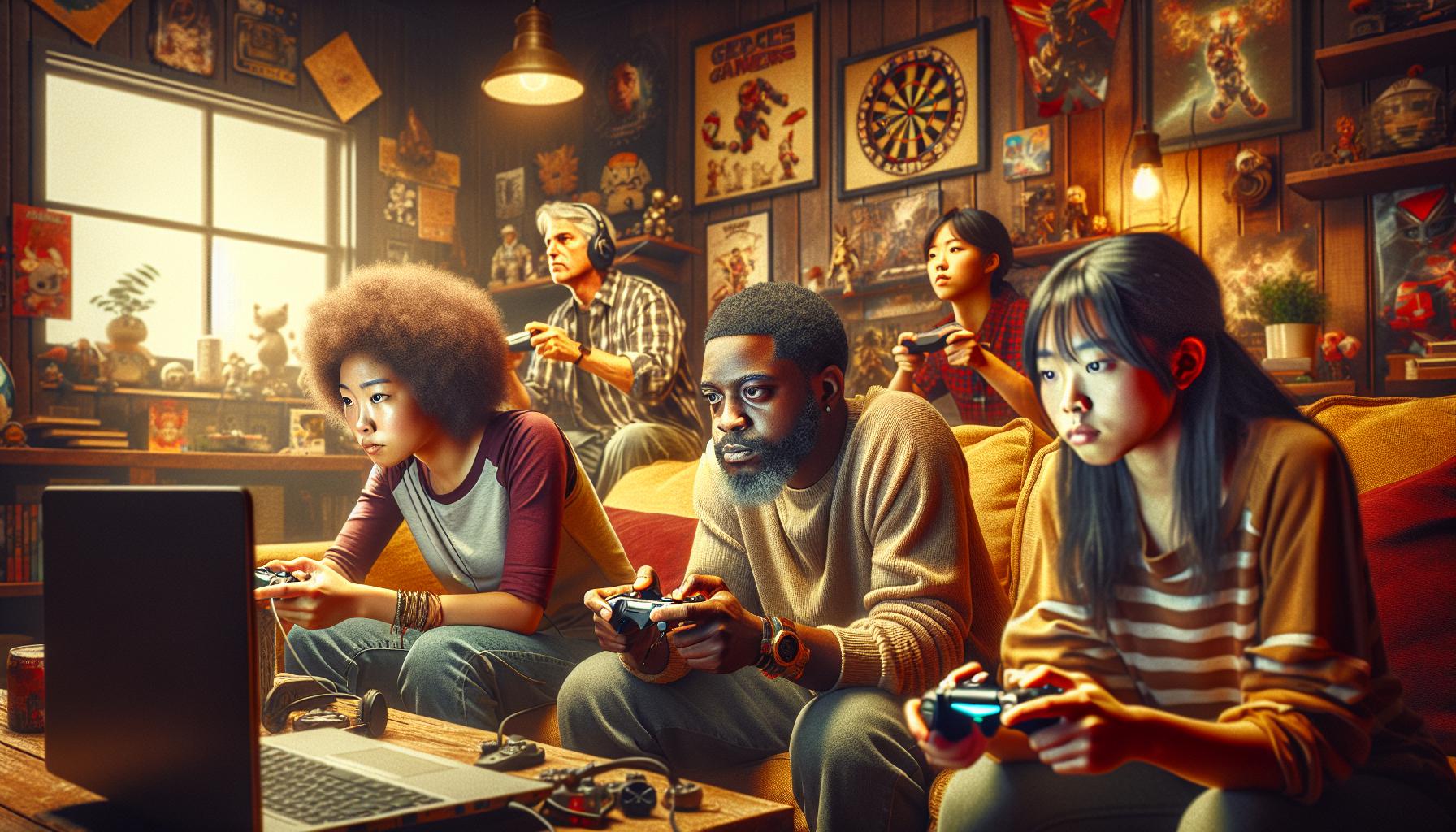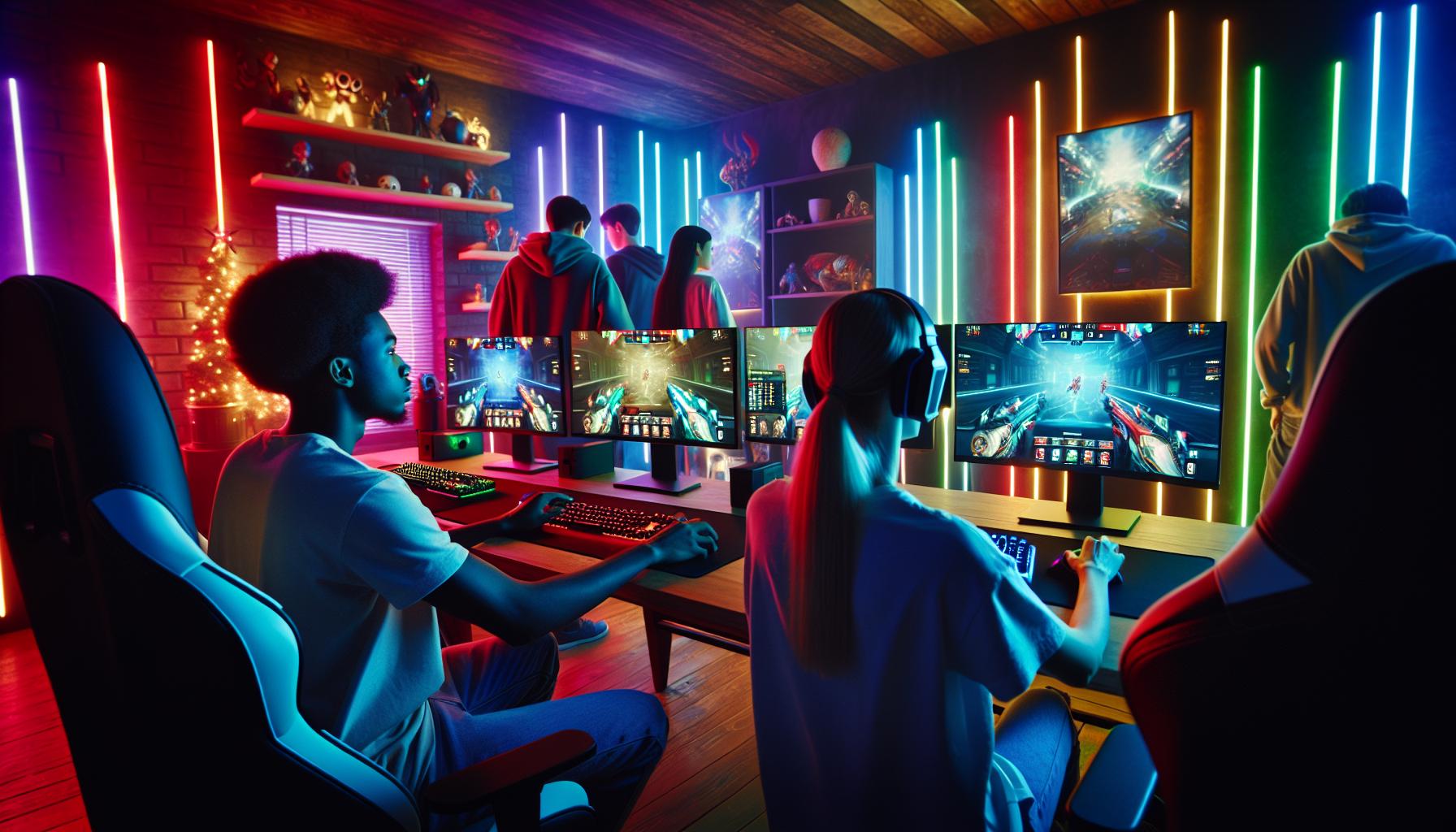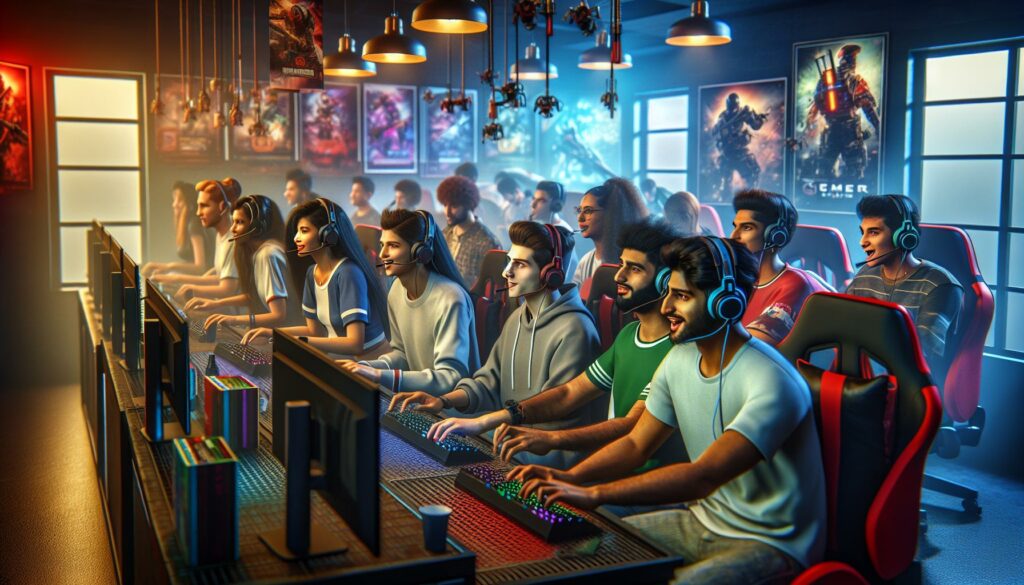Video games have become deeply woven into America’s cultural fabric, transforming from a niche hobby into a mainstream phenomenon that shapes entertainment, social interaction, and even professional careers. From the early days of arcade machines to today’s cutting-edge virtual reality experiences, gaming has evolved into a multi-billion dollar industry that captures the imagination of millions across the United States.
American gaming culture stands out for its unique blend of competitive spirit and community-driven engagement. Whether it’s massive esports tournaments filling stadiums or casual gaming sessions among friends, the social aspect of gaming has created countless communities where players share experiences, strategies, and memorable moments. It’s not just about playing anymore – it’s about streaming, creating content, and building connections in an ever-expanding digital universe that’s distinctly American in its entrepreneurial approach and innovative spirit.
American Gaming Culture
Gaming transformed American entertainment culture from basic pixel games to immersive digital experiences. This evolution reflects technological advancement integrated into daily social interactions.
From Arcade Halls to Living Rooms
The 1970s marked the beginning of arcade gaming culture in America with the introduction of Pong in 1972. Local arcades became social hubs where players gathered to compete on popular titles like Space Invaders Pac-Man Space Ace Dragon’s Lair. The transition to home gaming began in 1977 with the Atari 2600 bringing arcade experiences directly into American households. By 1983 arcade revenues peaked at $3.2 billion demonstrating the cultural impact of gaming establishments. Gaming enthusiasts shifted from public spaces to private gaming sessions creating intimate multiplayer experiences through early home consoles.
The Rise of Console Gaming Culture
The Nintendo Entertainment System revitalized the American gaming market in 1985 selling 34 million units. Console wars between Sega Genesis Nintendo SNES created distinct gaming communities brand loyalties throughout the early 1990s. The PlayStation launch in 1995 introduced 3D graphics CD-quality audio establishing gaming as premium entertainment. Online connectivity through Xbox Live in 2002 connected 3 million players transforming living room gaming into a social network. Modern consoles like PlayStation 5 Xbox Series X emphasize 4K graphics ray tracing digital distribution making gaming more accessible sophisticated than arcade predecessors.
Social Aspects of American Gaming

American gaming culture extends beyond individual gameplay into rich social networks that connect millions of players across digital platforms. Gaming communities foster relationships through shared experiences collaborative achievements.
Online Communities and Gaming Identity
Digital platforms create unique social spaces where gamers develop distinct identities through avatars usernames Discord servers. Gaming communities form around specific titles genres platforms connecting players through shared interests strategies achievements. Platforms like Twitch YouTube enable content creators to build dedicated followings while fostering interactive relationships with their audiences. Discord servers host millions of gaming-focused communities where members share strategies organize events discuss gaming news. These digital spaces transcend geographical boundaries creating lasting friendships professional connections collaborative opportunities among players with common interests.
Competitive Gaming and Esports
Esports transformed American gaming culture into a professional competitive landscape with organized leagues tournaments prize pools. Major events fill traditional sports venues drawing thousands of spectators millions of online viewers. Professional teams compete in games like League of Legends Valorant Counter-Strike generating substantial revenue through sponsorships merchandise broadcasting rights. The North American esports market generates over $300 million annually creating career opportunities for players coaches analysts content creators.
| Esports Statistics | Value |
|---|---|
| Annual Revenue | $300M+ |
| Pro Teams | 150+ |
| Average Tournament Prize Pool | $100K-$1M |
| Active Viewers | 30M+ |
Gaming Demographics in America

Gaming demographics in America span diverse age groups, genders, and geographical locations, reflecting the broad appeal of digital entertainment across the population. Recent studies indicate 227 million Americans identify as active gamers, representing 66% of the total population.
Age and Gender Dynamics
The gaming population demonstrates significant diversity across age brackets and gender representation. Adults aged 18-34 comprise 38% of gamers, while those 34-54 represent 26% of players. The gender distribution shows 45% of gamers identify as female, challenging traditional assumptions about male dominance in gaming. Mobile gaming attracts 65% of female players, compared to 56% of male players. Generation Z gamers (ages 18-24) spend an average of 7.3 hours weekly playing video games.
| Age Group | Percentage of Gamers |
|---|---|
| 18-34 | 38% |
| 34-54 | 26% |
| 55+ | 21% |
| Under 18 | 15% |
Regional Gaming Preferences
 Gaming preferences vary significantly across American regions. East Coast gamers gravitate toward competitive multiplayer games like MOBAs and battle royales. The Midwest shows higher engagement with sports games and farming simulators. West Coast players demonstrate strong preferences for fighting games and esports titles. Southern states record the highest mobile gaming adoption rates at 73% of players. Metropolitan areas report 22% higher PC gaming rates compared to rural regions.
Gaming preferences vary significantly across American regions. East Coast gamers gravitate toward competitive multiplayer games like MOBAs and battle royales. The Midwest shows higher engagement with sports games and farming simulators. West Coast players demonstrate strong preferences for fighting games and esports titles. Southern states record the highest mobile gaming adoption rates at 73% of players. Metropolitan areas report 22% higher PC gaming rates compared to rural regions.
| Region | Top Gaming Platform | Most Popular Genre |
|---|---|---|
| East Coast | PC Gaming | MOBAs |
| Midwest | Console | Sports Games |
| West Coast | PC/Console Hybrid | Fighting Games |
| South | Mobile | Casual Games |
Impact on American Entertainment

Gaming shapes American entertainment through innovative storytelling techniques digital interactions across multiple media platforms. The integration of gaming elements transforms traditional entertainment consumption patterns creating new hybrid forms of media engagement.
Gaming’s Influence on Movies and TV
 Video game adaptations generate significant box office revenue with films like “The Super Mario Bros. Movie” earning $1.36 billion globally. Major streaming services incorporate gaming properties into their content strategies through series adaptations such as “The Last of Us” “Arcane” “Castlevania.” Hollywood productions adopt gaming visual effects techniques incorporating CGI motion capture real-time rendering technologies pioneered by game developers. Popular shows utilize gaming concepts through interactive episodes including Netflix’s “Black Mirror: Bandersnatch” “Minecraft: Story Mode.” Video game narrative structures influence modern television with non-linear storytelling multiple plot branches character customization options becoming more prevalent.
Video game adaptations generate significant box office revenue with films like “The Super Mario Bros. Movie” earning $1.36 billion globally. Major streaming services incorporate gaming properties into their content strategies through series adaptations such as “The Last of Us” “Arcane” “Castlevania.” Hollywood productions adopt gaming visual effects techniques incorporating CGI motion capture real-time rendering technologies pioneered by game developers. Popular shows utilize gaming concepts through interactive episodes including Netflix’s “Black Mirror: Bandersnatch” “Minecraft: Story Mode.” Video game narrative structures influence modern television with non-linear storytelling multiple plot branches character customization options becoming more prevalent.
Streaming and Content Creation
Gaming content creators attract massive audiences on platforms like Twitch YouTube generating over $28 billion in revenue annually. Top gaming streamers maintain dedicated viewership bases exceeding 10 million followers. Live streaming platforms host 8.4 million active streamers creating gaming content across different genres formats. Gaming channels produce diverse content including gameplay tutorials reviews esports coverage entertainment shows. Content creators establish personal brands through consistent engagement subscriber communities merchandise lines sponsorship deals. Streaming platforms integrate features like channel points custom emotes subscriber badges fostering viewer interaction community building. Gaming influencers impact purchasing decisions marketing strategies across the entertainment industry through product recommendations sponsored content collaborations.
Cultural Controversies and Debates
Gaming culture in America faces ongoing debates about its societal impact, sparking discussions among parents, researchers, legislators, and the gaming community. These discussions center on potential risks and benefits of gaming in modern society.
Violence in Video Games
Research on the connection between video game violence and real-world behavior remains complex and contested. The American Psychological Association reports that 71% of games contain some form of violence, though studies show varying results regarding behavioral impacts. Major debates emerged after high-profile incidents like the Columbine shooting in 1999, leading to industry changes such as the Entertainment Software Rating Board (ESRB) ratings system. Congressional hearings in 1993 resulted in the creation of content warnings, while game developers implemented parental controls across platforms. Studies from organizations like the FTC indicate that 87% of parents use these rating systems to make informed purchasing decisions.
Gaming Addiction Concerns
The World Health Organization’s recognition of Gaming Disorder in 2018 intensified discussions about excessive gaming habits. Research indicates that 3-4% of gamers experience symptoms matching addiction criteria. Common signs include decreased academic performance, disrupted sleep patterns, and strained relationships. The American gaming industry responded by implementing features like play-time tracking tools, screen-time limits, and in-game warning systems. Mental health organizations report that 10% of American youth between ages 8-18 display gaming behavior patterns that interfere with daily activities. Treatment centers across 45 states now offer specialized programs for gaming-related behavioral issues.
The Future of American Gaming Culture
 Cloud gaming services transform traditional gaming experiences by enabling instant access across multiple devices. Major tech companies like Microsoft xCloud Google Stadia deliver AAA titles through streaming platforms eliminating hardware barriers.
Cloud gaming services transform traditional gaming experiences by enabling instant access across multiple devices. Major tech companies like Microsoft xCloud Google Stadia deliver AAA titles through streaming platforms eliminating hardware barriers.
Virtual reality technology advances create more immersive gaming experiences with improved haptic feedback systems gesture controls. Meta’s Quest platform PlayStation VR2 demonstrate growing consumer adoption of VR gaming reaching 14 million active users in 2023.
Cross-platform integration emerges as a dominant trend with games supporting seamless play between mobile consoles PCs. Epic Games’ Fortnite exemplifies this shift connecting 350 million players across different devices fostering unified gaming communities.
Artificial intelligence enhances gaming experiences through:
- Adaptive difficulty systems that personalize challenge levels
- Procedurally generated content creating unique gameplay scenarios
- NPCs with advanced behavioral patterns realistic interactions
- Dynamic storytelling that responds to player choices actions
Gaming accessibility features expand reaching broader audiences through:
- Customizable control schemes
- Color blind modes
- Text-to-speech options
- Adaptive controllers for players with disabilities
The metaverse concept shapes gaming’s future direction by:
- Creating persistent virtual worlds
- Supporting real-time social interactions
- Enabling virtual commerce digital ownership
- Integrating blockchain technology NFTs
Sustainable gaming practices gain prominence focusing on:
- Energy-efficient hardware designs
- Cloud computing optimization
- Digital distribution reducing physical waste
- Eco-friendly packaging materials
- Game development roles
- Content creation opportunities
- Esports management positions
- Gaming journalism careers
- Virtual event coordination
Multi-Billion Dollar Empire
American gaming culture stands as a testament to the remarkable evolution of digital entertainment. What began in dimly lit arcades has transformed into a dynamic force that shapes entertainment social connections and career opportunities across the nation.
The fusion of competitive spirit community engagement and technological innovation continues to drive the gaming industry forward. From casual mobile games to professional esports American gaming culture embraces diversity and inclusivity while fostering meaningful connections in an increasingly digital world.
As virtual reality cloud gaming and the metaverse emerge gaming’s influence on American society will only grow stronger. This vibrant cultural phenomenon reflects not just how Americans play but how they connect create and compete in the modern digital age.



